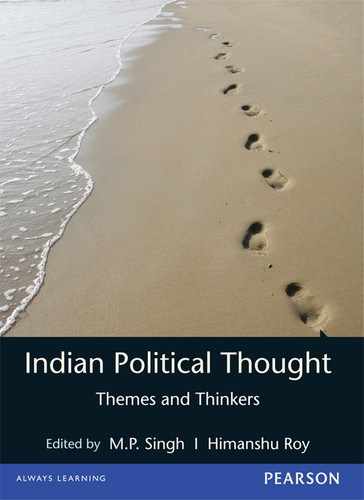Chapter 6
1. Gail Omvedt, Dalit Visions: The Anti-Caste Movement and the Construction of an Indian Identity (New Delhi: Orient Longman Private Limited, 2006), p. 23.
2. Accounts differ about the year of his birth; the year of his birth may be either 1827 or 1828.
3. G. P. Deshpande (ed.), ‘Introduction’, Selected Writings of Jotirao Phule (New Delhi: Leftword, 2002), pp. 2–4.
4. Ibid., p. 3.
5. Rosalind O’Hanlon, ‘Caste, Conflict and Ideology’, Mahatma Jyotiba Phule and Low-Caste Social Protest in Nineteenth Century Western India (Cambridge: Cambridge University Press, 1985), pp. 5–6.
6. Mahesh Gavaskar, ‘Colonialism with Colonialism: Phule’s Critique of Brahmin Power’, in. S. M. Michael ed. Dalits in Modern India: Vision and Values, (New Delhi: Sage Publications India Pvt. Ltd), pp. 92–93.
7. Rosalind O’Hanlon, op. cit., pp. 7–8.
8. Gail Omvedt, op. cit., p. 18.
9. G. P. Deshpande (ed.), op. cit., pp. 36–37.
10. Ibid., p. 27.
11. Ibid., p. 28.
12. Ibid., p. 29.
13. Ibid.
14. Ibid., pp. 44–45.
15. Ibid., p. 44.
16. Ibid., pp. 32–33.
17. Ibid., p. 38.
18. Ibid., p. 129.
19. Ibid., p. 168.
20. Ibid., p. 49.
21. Ibid.
22. Ibid., p.63–64.
23. Ibid., pp. 67–68.
24. Ibid., pp. 73–74.
25. Ibid., p. 87.
26. Gail Omvedt, op. cit., p. 18.
27. G. P. Deshpande (ed.), op. cit., p. 176.
28. Ibid., p. 177.
29. Ibid.
30. Rosalind O’Hanlon, op. cit., pp. 303–304.
31. Mahesh Gavaskar, op. cit., p. 91.
32. G. P. Deshpande (ed.), op. cit., p. 89.
33. Ibid., pp. 166–167.
34. Ibid., p. 169.
35. Gail Omvedt, Cultural Revolt in a Colonial Society: The Non Brahman Movement in Western India (1873–1930) (Bombay: Scientific Socialist Education Trust, 1976), p. 118.
36. G. P. Deshpande (ed.), op. cit., p. 117.
37. Uma Chakravarti, Rewriting History: The life and Times of Pandita Ramabai (New Delhi: Kali for Women, 1998), p. 68.
38. G. P. Deshpande (ed.), op. cit., pp. 170–171.
39. Ibid., p. 33.
40. Rosalind O’Hanlon, A Comparison between Women and Men: Tarabai Shinde and the Critique of Gender Relations in Colonial India (Madras: Oxford University Press, 1994), p. 18.
41. Vidyut Bhagwat, ‘Jotirao Phule, Satyashodhak Samaj and the Woman Question,’ Jyotiba Phule: An Incomplete Renaissance, Seminar Papers (Surat: Centre for Social Studies, 1991), p. 202.
42. G. P. Deshpande (ed.), op. cit., pp. 15–16.
43. G. P. Deshpande (ed.), op. cit., p. 226.
44. Ibid., p. 225.
45. G. P. Deshpande (ed.), op. cit., p. 229.
46. Ibid., p. 229–230.
47. Ibid., p. 229.
48. Ibid., p. 233.
49. Ibid., pp. 235–236
50. Gail Omvedt (see note 1), p. 21.
51. Yogendra Singh, Modernisation of Indian Tradition, (Jaipur: Rawat Publications, 1986), p. 53.
52. Gail Omvedt, Dalits and the Democratic Revolution (New Delhi: Sage Publications, 1994), pp. 148–149.
53. Now a very current cutting edge genetic research carried out by Harvard and indigenous researchers have found the Aryan-Dravidian theory scientifically incorrect. Genetically speaking, they are one people. The Times of India, ‘Aryan-Dravidian Race Divide is a Myth,’ (New Delhi, 25 September 2009).
54. Gail Omvedt, op. cit., p. 19.
55. Rosalind O’Hanlon, op. cit., pp. 206–207.
